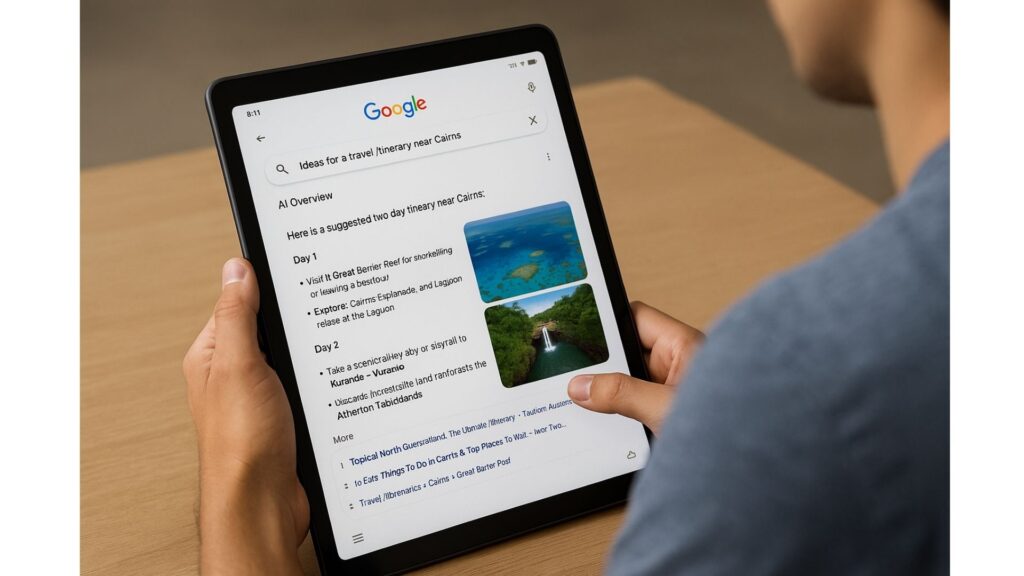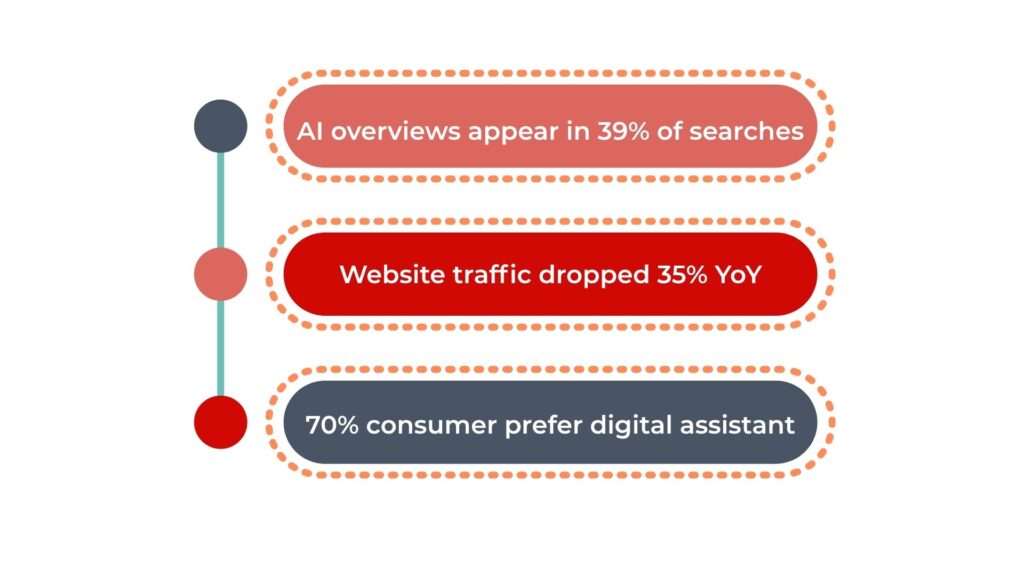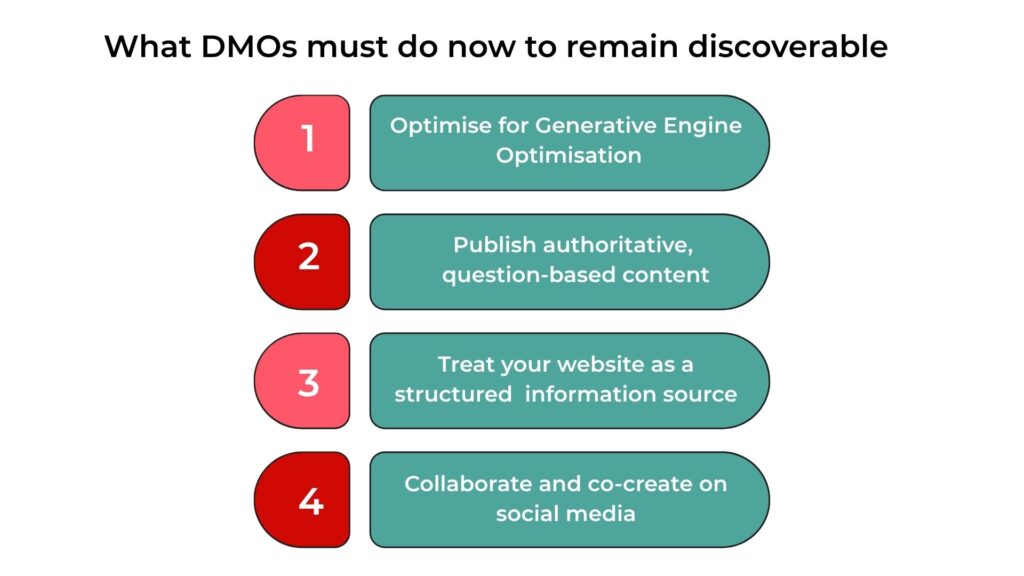
Let us help
Related articles
How AI Search Is Transforming Tourism Marketing in Australia
Be sure to check out our content hub on AI in the travel industry. It links all our AI resources available for free to tourism and travel businesses and organisations.
How AI Search Is Transforming Tourism Marketing in Australia
A new era for digital discovery in tourism
AI is creating the most profound disruption the tourism industry has seen since the rise of the internet. Having led the development of Queensland’s first destination websites, Sunlover Holiday’s agents’ online booking systems, and the ATDW (Australian Tourism Data Warehouse) during the dot-com boom, I can say with confidence that this moment is even more transformative.
Google’s launch of AI Mode in Australia has turned the world’s largest search engine into a conversation partner. Travellers no longer type and click; they ask and receive curated answers, itineraries, and booking options, all without leaving the search page.

For tourism, this means two things: the digital customer journey has fractured, and traditional SEO and content marketing are no longer enough to win visibility.
In this article, we draw on Tourism Tribe’s own testing and global insights to unpack what these changes mean for DMOs (destination marketing organisations) and operators, and how they can remain visible and relevant in the new AI search landscape.
How AI is changing traveller behaviour
McKinsey’s report The New Front Door to the Internet describes this shift as “the collapse of the open web” as users migrate from browsing to conversing. 70% of online sessions still begin with search, yet an increasing share of user time is now spent inside AI-aggregated environments, not on individual websites.
Tourism Tribe’s testing of Google’s AI Mode, including Fabienne Wintle’s live search for “things to do in Agnes Water 1770”, reveals just how radical the change is. In AI Mode, Google’s chat-style interface summarises top experiences without displaying the usual destination marketing links. When the query shifts to “how do I book?”, AI Mode switched to Google Business Profile listings, showcasing operators’ websites, phone numbers and booking buttons.
This simple test exposed a clear reality: DMO websites are being bypassed, while operators with complete, verified listings are being surfaced at the exact point of consideration on the conversion pathway.
ABC’s analysis of SimilarWeb data shows that traffic to Australian content and news sites from Google Search has already dropped by up to 35% year-on-year since AI summaries rolled out. Website Planet found that AI overviews now appear in 39% of searches, with click-through rates to traditional results falling by a third.
Our own analysis of DMO clients’ web traffic shows similar declines of around 30% down on the same time last year.

The implications for tourism marketing are enormous and require a complete rethink of DMO digital strategies.
From ten tabs open to one conversation: the new travel research journey
Travellers are no longer opening ten tabs to compare “top things to do in Noosa.” They’re asking questions like “looking for a relaxed long weekend in Noosa with ocean views and great seafood?” and receiving a summarised itinerary drawn from trusted sources, often user-generated content, local blogs, or Google Business Profiles.
McKinsey’s Remapping Travel with Agentic AI report confirms this pattern globally: more than half of travellers have already used AI tools to plan a trip, and 70% say they would prefer a digital assistant that could plan and manage their entire itinerary autonomously.
For DMOs, this means the traditional top-of-funnel activity – inspiring and informing travellers – is now being mediated by AI engines that repackage destination content into summaries.
So the definition of a win in search results has changed completely for DMOs. When your destination’s content is structured clearly, verified, and authoritative, AI will quote it. In this sense, success no longer means driving clicks; it means earning inclusion in AI-generated results.
The dream to book continuum: what DMOs must understand
The tourism purchase cycle — dream, plan, book, experience — still applies. What has changed is where influence lives along that continuum.
- Dream and Plan (front end): AI-powered summaries and conversation tools dominate.
- Book and Experience (back end): Google’s ecosystem and operators’ structured data drive visibility.
DMOs traditionally own the dream and plan stages, while operators and OTAs (online travel agencies) handle booking and experience delivery. But AI search is blurring those boundaries.
In discussion with DMO clients recently as they are watching their web site visitation slide, we agreed that content-marketing-driven SEO is no longer the key strategy for driving traffic. Instead, AI summaries are absorbing attention while still echoing the DMO’s language and recommendations, providing proof that trustworthy, structured content can influence without clicks.
The opportunity for DMOs lies in redefining their success metrics: away from page sessions, and toward discoverability in AI environments. The goal is to be the source AI trusts, even if the traveller never lands on your site.
Musing about the future of DMO websites I can see them not only providing that trusted source of information, but also offering two important roles that stimulate intent to visit:
Firstly, transforming their websites to platforms for curated collections of the most inspiring, entertaining and engaging content – a place where potential visitors can be absorbed in the beauty and uniqueness of the experiences on offer. The formats of content will only be limited by imagination and of course, budget.
Secondly, offering local online concierge services that strengthen interest and commitment to visit. A personalised customer experience will see the intersection of customer-specific itineraries and advice supported by reliable and granular detail that pre-empts and answers the customers’ questions.
What DMOs must do now to remain discoverable
1. Optimise for Generative Engine Optimisation (GEO)
This new discipline sits at the intersection of SEO and structured data. GEO ensures that your content is easy for AI systems to read, interpret, and quote. It relies on schema markup, conversational content, and clear metadata.
2. Publish authoritative, question-based content
Use natural language and location-based questions e.g., “What are the best free family activities in Bundaberg?”, then answer them thoroughly in your content.
3. Treat your website as a structured information source
Even if AI reduces traffic, your site remains your single source of truth. Every piece of information should be verified, factual, and machine-readable.
4. Collaborate and co-create on social media
Tourism Australia’s latest Market Briefing on the Gold Coast emphasised: “Optimise your content for discoverability. Focus on your platform foundations. Experiment and be authentic. Share the details of your experiences with @Australia.”
In the AI era, social media is not just a marketing tool – it’s a data source. AI tools increasingly pull from social platforms for authentic, local perspectives. DMOs that ‘lean in’ to social, share behind-the-scenes stories, and encourage operators and locals to contribute will build the kind of digital footprint AI rewards.

Operators: where the AI opportunity is real
While DMOs face visibility challenges, operators are quietly gaining ground. When a traveller asks “How do I book?”, AI turns to structured sources – Google Business Profiles, ATDW listings, and reviews – not long-form web content. In fact, we were surprised during our recent testing to see Google return an operator’s listing that is available on atdw.com.au, rather than the relevant DMO’s website that have been the primary access point for the ATDW listings, having integrated them in line with their destination marketing strategies.
Operators who treat these listings as extensions of their website are already seeing results. The formula is simple:
- Keep your Google Business Profile complete and current (photos, hours, FAQs, links).
- Encourage and respond to reviews – AI uses these as signals of trust.
- Align your ATDW listing and website so that names, addresses, key points of difference, and experiences align.
- Maintain recent, high-quality images and concise descriptions that AI can summarise easily.
As Tourism Australia continues to advise: build strong platform foundations, then experiment and optimise. Operators who do so are more likely to appear in AI recommendations and Google Maps results.
The DMO dilemma: bookings, trust and the premium experience
DMOs have rarely excelled at bookings unless they operate as commercially structured entities. In most cases, the transaction layer has been clunky, under-resourced, or disconnected from operators’ real-time availability.
In the AI era, that challenge only deepens.
To succeed as a booking channel, a DMO would need to deliver AI-driven personalised itineraries, fully integrated with live product feeds and concierge-style online customer service. The experience across the entire purchase cycle – from inspiration to confirmation – must feel premium, frictionless, and infused with local expertise.
For most DMOs, that’s an unrealistic operational load. Their most valuable and achievable role remains trust and discovery: providing authoritative, structured, and inspirational content that AI can confidently use to represent the destination.
Agentic AI: the next disruption to travel booking
McKinsey and Skift’s Remapping Travel with Agentic AI paints a clear picture of what comes next. The next generation of AI, “agentic AI”, moves beyond advising travellers to acting on their behalf. These systems will not only recommend experiences but book and manage entire itineraries autonomously.
Imagine a traveller’s AI assistant that remembers past trips, loyalty memberships, and preferences – and automatically plans a family getaway or a business trip within specified parameters. This is not science fiction. Early examples like SkyLink, a corporate travel agent powered by AI, already automate flight and accommodation booking within seconds.
For tourism operators, this shift will demand data consistency, live connectivity, and interoperability. For DMOs, it underscores why the open web, and your own website, must remain a structured, trustworthy foundation for these AI agents to draw from.
What Tourism Tribe is seeing on the ground
Across hundreds of coaching sessions, workshops, and strategy programs, we’re witnessing the early divide between businesses that adapt and those that disappear.
- Adaptive operators are using AI to speed up marketing, create better content, and test how their business appears in generative search.
- Passive operators – those without structured websites or updated listings – are invisible in AI results.
We’re also seeing DMOs asking the same question: What is our role in the AI-powered travel purchase cycle?
Our advice remains consistent:
- Focus on trust, structure, and storytelling.
- Build GEO readiness and social discoverability.
- Collaborate deeply with local operators to ensure your region’s digital footprint is accurate, diverse, and visible.
The future of travel: from AI to agent companions
The next transformation will come as agentic AI systems evolve into personal travel companions – tools that know their users intimately, compare destinations dynamically, and book experiences autonomously.
McKinsey’s research predicts that as AI gains autonomy, 70% of consumers will prefer these ‘travel agents in their pocket.’ When that happens, visibility will depend less on website traffic and more on data quality, authenticity, and emotional storytelling.
For Australia’s tourism industry, the opportunity is to build the digital foundations now, so that when these AI companions go shopping for experiences, they find yours first.
The bottom line: visibility in the age of AI
AI isn’t just changing how people find travel information – it’s changing who gets found.
DMOs must evolve from content publishers to data custodians and storytellers. Operators must treat their digital presence as their storefront in AI search. And the whole industry must embrace collaboration and authenticity across every platform.
At Tourism Tribe, we’re helping businesses across Australia build that readiness – from AI-optimised content and schema, to GEO strategy and staff training.
Because the future of search isn’t about keywords. It’s about context, credibility, and connection.
Where to from here?
Top AI Tools for the Tourism Industry - Free cheatsheet

